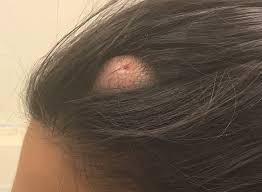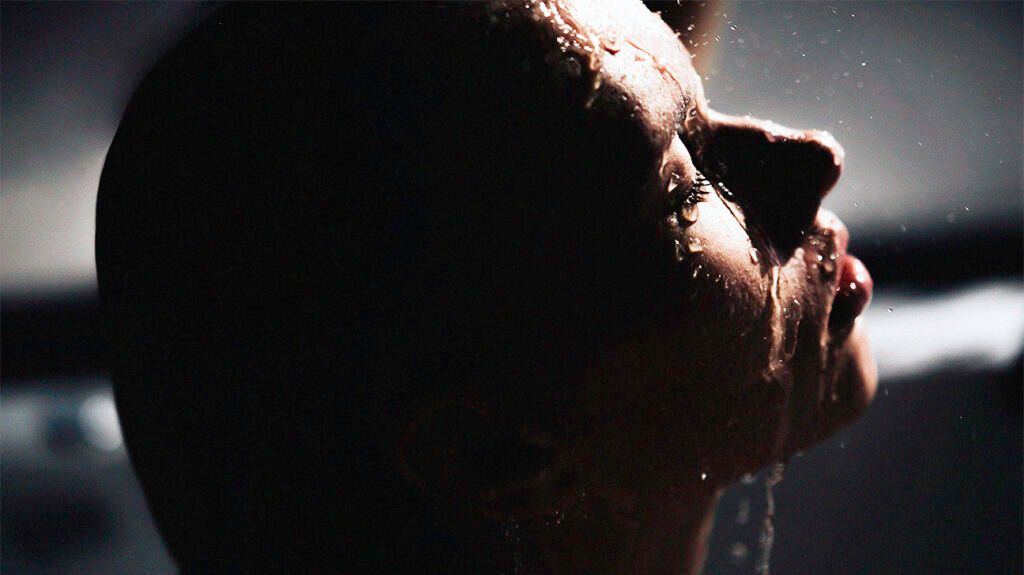
Pilar cysts grow around hair follicles and usually appear on the scalp. They are small yellow, white, or discolored bumps that may be round or dome-shaped. They grow slowly and may disappear on their own, or a doctor can remove them.
A cyst is a small fluid-filled lump that forms under the skin. Cysts are very common. They usually have no symptoms or side effects.
There are several names for a pilar cyst: a wen, trichilemmal cyst, and isthmus-catagen cyst.
There are three main types of cysts: epidermoid, meibomian (chalazion), and pilar cysts. Pilar cysts occur in less than 10%Trusted Source of the population.
Many pilar cysts heal without treatment if a person is careful not to damage the skin.
A surgeon is usually able to remove a cyst easily. However, sometimes, the cyst may reappear after removal.
How do you identify a pilar cyst?
Warning
Contains Sensitive Content
VIEW GALLERY
A cyst looks like a small, round, or dome-shaped bump. Some pilar cysts are yellow, white, or discolored. Pilar cysts tend to be between 0.5 and 5 centimeters (cm). Because they grow very slowly, a person may not notice a pilar cyst until it reaches a certain size.
A doctor can identify pilar cysts by their location. They develop around hair follicles. A follicle is a collection of cells forming a tube or sheath around a single hair.
Because most of the body’s hair is on the head, 90% of pilar cysts grow on the scalp. No hair usually grows on the lump formed by the cyst, which may make it easier to see.
This type of cyst also has no dark point in its center. The skin covering a pilar cyst is less fragile than an epidermoid cyst.
A doctor can also recognize a pilar cyst under a microscope. An epidermoid cyst has skin cells covering it. A pilar cyst has keratin, the protein found in skin and hair cells.
A person is likely to develop more than one pilar cyst at a time.
What do pilar cysts feel like?
A pilar cyst is firm to the touch. Because cysts contain fluid, they may move slightly when pressed. Pressing a cyst too hard can cause pain or soreness.
Cysts may be tender if there is an infection.
The skin covering a pilar cyst is thick, making it less likely to break or pop. However, brushes or combs can catch cysts on the scalp, breaking the skin and allowing pus to leak from the cyst.
Pilar cyst causes and risk factors
Keratin helps keep skin and hair strong and flexible. When keratin cells die, they usually move to the skin’s surface and either drop off or wash away.
If these cells move deeper into the skin, they can multiply and form a pilar cyst. The keratin in a cyst resembles a thick white or yellow paste.
Pilar cysts can run in families. If a parent has one, there is a 1 in 2 chance a child will develop a pilar cyst too.
Pilar cysts are also more common in females than in males. They can affect people of all ethnic and racial groups. They usually occur in middle-aged adults.
There are no apparent risk factors for pilar cysts. However, a person with damaged hair follicles or injured skin may be more likely to develop them.
Pilar cyst concerns
Complications from a pilar cyst are rare. They can include:
- Infection: If bacteria get into the cyst, it can become infected. The infection can progress beyond the initial cyst into the tissue and bone if not treated.
- Tumor: Very rarely, a pilar cyst can develop into a tumor called a proliferating trichilemmal cyst. This only happens in about 3%Trusted Source of pilar cyst cases. The cyst cells multiply, and the lump grows and may ulcerate. These tumors grow slowly and are not usually cancerous.
- Recurrence: After removal, a scar will form. However, the cyst may grow back.

HEALTHLINE NEWSLETTER
Get our free anti-inflammatory recipes
We rounded up a few nutritious and anti-inflammatory recipes for you to try next time you need inspiration in the kitchen. Join our psoriasis newsletter for your free recipes and expert guidance twice a week.
Enter your emailJOIN NOW
Your privacy is important to us
Diagnosing pilar cysts
A doctor or dermatologist can check any lumps or bumps on the skin. Cysts are usually not a cause for concern. However, getting the right diagnosis is essential.
A doctor or dermatologist will carefully examine the cyst. They may ask about medical history and additional symptoms.
A doctor may use a CT scan or MRI to determine whether the cyst has reached the deeper soft tissue or bone.
If a doctor cannot visually diagnose a cyst, they may remove it and examine it under a microscope to ensure it is not harmful.
Pilar cyst treatment
Cysts often heal on their own. Holding a clean, warm washcloth to a cyst can reduce swelling and help it heal.
Doctors usuallyTrusted Source prescribe antibiotics to treat an infected pilar cyst.
It is not always necessary to remove a cyst. If the cyst is not causing symptoms, a person may decide not to seek treatment.
Removal
Since pilar cysts usually form on the scalp, catching one when dressing or brushing the hair can be painful. If a cyst is causing discomfort, a person can have it removed.
Before cyst removal, a person receives a local anesthetic to reduce pain. There are two methods of removal:
- making a small cut in the skin to drain the cyst of fluid
- removing the entire cyst without cutting into it
The procedure is usually quick and does not require an overnight stay in a hospital or clinic.
Doctors apply a dressing after removing the cyst. It is generally recommended to avoid getting the dressing wet and take care when touching the affected area.
Frequently asked questions
Here are some frequently asked questions about pilar cysts.
Can you pop a pilar cyst?
A person should avoid scratching, popping, or picking at a cyst. Doing so can cause the area to become infected.
Always wash your hands before touching the area. If you want your cyst removed, have a doctor perform the procedure.
What is inside a pilar cyst?
Keratin is inside a pilar cyst. The keratin resembles a thick white or yellow paste.
Can pilar cysts cause cancer?
In extremely rare casesTrusted Source, a proliferating trichilemmal cyst can become cancerous. If this type of cyst develops, a person may wish to have the cyst evaluated.
How do you prevent a pilar cyst?
A pilar cyst is less likely to grow back if a doctor removes it entirely rather than draining it. However, a person cannot fully prevent a pilar cyst from coming back after surgery.
Summary
Pilar cysts usually form around the hair follicles on the scalp. They are not contagious and are usually harmless. When infected, they can cause pain or discomfort. A doctor can prescribe medication for this.
In rare cases, a pilar cyst may develop into a tumor. However, it is usually not cancerous.
A person may have more than one pilar cyst at a time, and they may disappear and return. In most cases, a cyst causes no symptoms and heals without treatment.
If necessary, a doctor can remove a cyst with a simple procedure. The cyst may reappear in the same location, and new cysts may develop.
Last medically reviewed on May 28, 2024
How we reviewed this article:
Sources
Share this article

Medically reviewed by Reema Patel, MPA, PA-C — Written by Claire Sissons — Updated on May 28, 2024
Latest news
- Anti-amyloid drug may help reduce the risk of early-onset Alzheimer’s by 50%
- Scientists unveil how key protein malfunctions and leads to Parkinson’s
- Is excessive sleepiness as we age a warning sign of dementia?
- Study finds why ‘night owls’ have a higher risk for depression than ‘early risers’
- Is brain inflammation at the core of cognitive decline? What latest research says
Was this article helpful?
What is an epidermoid cyst?
- What is it?
- Symptoms
- Causes
- Treatment
- Who they affect
- Complications
- Diagnosis
- Contacting a doctor
- Outlook
- Summary
An epidermoid cyst is a lump under the skin. Epidermoid cysts usually do not require treatment, unless a person wants to have them removed due to cosmetic reasons, or if the cyst becomes infected.
Epidermoid cysts are usually harmless, but they can have some risks if they rupture or “pop”. It is for this reason that people should not attempt to pop or remove them at home. Only a doctor can do this safely.
In this article, we look at what an epidermoid cyst is, its symptoms, causes, and treatment options. We also discuss when a person should seek medical help.
What is an epidermoid cyst?

An epidermoid cyst is a slow-growing lump that appears under the skin. These cysts are not cancerous, but they can beTrusted Source painful.
A cyst typically has two features: the lining and the contents. The lining of an epidermoid cyst is made up of skin cells, which secrete keratin. Keratin is the material that makes up the hair and the outer layer of skin.
The contents of an epidermoid cyst are soft and “cheese-like”, with an unpleasant smell.
How is it different from a sebaceous cyst?
Some people refer to epidermoid cysts as a sebaceous cysts, but they are notTrusted Source the same thing. Sebaceous cysts are less common, and the contents consist of a clear, oily liquid that the sebaceous glands produce.
Symptoms of an epidermoid cyst
The main symptom of an epidermoid cyst is a lump, which can becomeTrusted Source painful if there is inflammation or an infection. A person is typically able to move the cyst slightly under the skin.
Epidermoid cysts vary in size from a tiny bumps to growths larger than a golf ball. Tiny epidermoid cysts are known as milia, or milk spots.
There may be a small dark pore-like “punctum” that indicates the opening of the cyst. Inside the cyst may be a yellowish, unpleasant-smelling material similar to soft cheese.
Epidermoid cysts can appear anywhere on the body but typically appear on the:
- face
- ears
- neck
- chest
- upper back
- scrotum
- vulva
Approximately 7%Trusted Source of epidermoid cysts develop in the head or neck area.
Causes of epidermoid cysts
Epidermoid cysts usuallyTrusted Source occur when there is a blockage of the hair follicle, which causes a cyst to form. As a result, they are common in people who experience acne, as they tend to have more blocked pores.
An epidermoid cyst may also form at the site of injury to the body.

HEALTHLINE NEWSLETTER
Get our free anti-inflammatory recipes
We rounded up a few nutritious and anti-inflammatory recipes for you to try next time you need inspiration in the kitchen. Join our psoriasis newsletter for your free recipes and expert guidance twice a week.
Enter your emailJOIN NOW
Your privacy is important to us
Treatment for epidermoid cysts
An epidermoid cyst may not need treatment as long as it is fairly small and not in an awkward place on the body. However, a healthcare professional may recommend removal if:
- there are signs of infection
- the cyst is large or prevents certain movements
- the cyst interferes with everyday life
Some people may also elect to have treatment for a cyst for cosmetic reasons.
When treatment is necessary, a medical professional may remove the cyst through surgical excision. This is the most effective treatment, as it reduces the risk the cyst will come back. However, it may not work as effectively if the cyst has ruptured.
For the procedure, a doctor will use a local anesthetic to numb the area, then aim to remove the whole cyst intact. If excision is not possible, they may drain it with a needle instead.
If an infection has occurred, a person may also need antibiotics.
After excision, a person may experience some swelling or pain while the wound heals. The procedure also has some risks. It may result in:
- damage to the surrounding tissues
- bleeding
- scarring
- infection
Who gets epidermoid cysts?
According to DermNet, epidermoid cysts most commonly occur in adults. They are twice as common in males than in females, but the reasons for this are unclear.
A person may also be more likely to develop epidermoid cysts if they have certain genetic disorders, including:
- basal cell nevus syndrome
- pachyonychia congenita type 2
- Gardner syndrome
Complications of epidermoid cysts
The most commonTrusted Source complications of epidermoid cysts occur if the cyst ruptures. It can result in:
- swelling
- pain
- inflamed skin
- localized cellulitis, which is a deep skin infection
It is for this reason that people should not try to pop or otherwise treat cysts themselves at home. Doing this can cause further damage.
A 2018 literature reviewTrusted Source notes that rarely, epidermoid cysts can become malignant, or cancerous. Cutaneous squamous cell carcinoma, basal cell carcinoma, and Merkel cell carcinoma can begin in an epidermoid cyst.
Diagnosing epidermoid cysts
At the first consultation, a doctor may physically examine the lump, looking for clinical signsTrusted Source that it is movable, and has a central dot, or punctum. This can indicate it is a cyst, and not something else.
If it is unclear what the lump is, they may ask further questions or recommend testing, such as an ultrasound scan. However, this is usually not necessary for epidermoid cysts.
After an excision, medical professionals may analyze the contents in a laboratory to confirm that the lump is only a cyst, and not something more serious.
When to contact a doctor
Anyone who has a lump under the skin with an unknown cause should speak with a doctor, particularly if it occurs with other symptoms, such as pain and inflammation. A doctor can identify what it is and whether it requires treatment.
Speak with a doctor promptly if the cyst:
- pops or ruptures
- becomes swollen and inflamed
- oozes pus
- is in an unusual or awkward place, such as the fingers or genitals
- is at risk of rupturing due to its location
Contact a doctor as soon as possible if a lump begins growing or changing quickly, even if a doctor previously diagnosed it as an epidermoid cyst.
Outlook for epidermoid cysts
The outlook for epidermoid cysts is usually positiveTrusted Source. Most epidermoid cysts are harmless, and excision can prevent them from returning, as long as a doctor removes the entire sac.
However, if the cyst has ruptured, it can be difficult to remove it completely. This can increase the chance of recurrence.
Rupturing can also pose a risk of infections, inflammation, and damage to the surrounding tissue.
Summary
Epidermoid cysts are harmless growths that occur due to a blocked hair follicle. They contain a soft, cheese-like substance known as keratin.
These cysts do not typically need treatment. However, they can sometimes cause distress, and may become inflamed or infected.
A person should see a healthcare professional to receive a correct diagnosis, as many conditions can cause lumps. A doctor can identify the condition and advise on the next steps.
